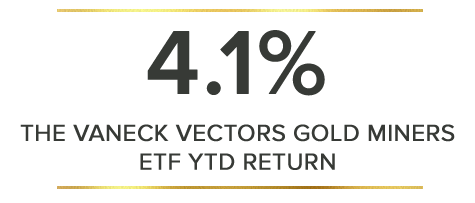
Tuesday, February 02, 2021
Has the VanEck Vectors Gold Miners ETF lost its Value?
By Century Financial in 'Brainy Bull'


The VanEck Vectors Gold Miners ETF [GDX] lost a bit of its shine during the first month of 2021. The ETF began the year at $38.51 on 4 January before dropping to $34.51 at the close on 29 January. The fund largely tracks the now faltering gold price, which has fallen from around $1,942 per ounce on 4 January to close the month at $1,846.72.
The drop in price was largely down to gains across US Treasury yields and the US dollar, as global economic news, such as US employment figures, improved. Furthermore, the roll-out of COVID-19 vaccines could prompt investors to continue to move out of the precious metal.
Last year, the VanEck Vectors Gold Miners ETF had opened at $29.62 on 2 January before sliding to a low of $16.18 on 16 March as pandemic fears took hold. However, it rebounded to end 2020 at $36.02, buoyed by low-interest rates and investors looking to safe-haven assets during the turbulence.
The spot price of gold, meanwhile, climbed from $1,528.90 on 2 January 2020 to $1,897.90 on 31 December.
The ETF’s year-to-date total daily return was down 4.1% at the start of February, according to Yahoo Finance, on net assets of $16.5bn. In comparison, the SPDR Gold Mini shares Trust’s [GLDM] return was down 2.6% on net assets of $4bn.


A gold mine
The ETF, launched on 16 May 2006, seeks to replicate the NYSE Arca Gold Miners Index [GDMNTR].
It has 53 holdings, including Newmont Corporation [NEM], which has the biggest weighting at 12.8% followed by Barrick Gold [GOLD] at 10.6%, Franco-Nevada [FNV] at 6.1%, and Wheaton Precious Metals [WPN] at 5%.
Shares in Newmont climbed 36% in the past year, from $43.84 on 29 January last year to $59.60 on 29 January 2021. The company reported record third-quarter results of $1.7bn EBITDA in October last year, despite COVID-19 disruptions at its mines.


Meanwhile, Barrick Gold’s share price has risen from $18.13 on 29 January 2020 to $22.37 on 29 January this year, after it hit guidance targets for gold production of 4.8 million ounces for the full year. Franco-Nevada’s shares have also climbed from $114.24 on 29 January last year to $119.33 on 29 January 2021, helped by record third-quarter revenues of $279.8m.
While the VanEck Vectors Gold Miners ETF has benefited from strong stock performances, its near and long-term performances will depend on the direction of the price of gold and the vagaries of global economies.
Safe-haven demand
Despite more confidence in the fight against COVID-19 and a corresponding boost to the global economy, market commentators forecast that gold prices are set to remain in the range of $1,800 to $1,900 an ounce in 2021 and 2022, according to MSN News.
“Positive news on the COVID-19 vaccine front in recent weeks should be further raising economic prospects for the second half of 2021 and will likely continue to support investors' appetite for risk ahead,” Steven Burke, an economist at Focus Economics, told the publication.


However, he adds that any logistical challenges to vaccine distribution and more mutant strains could push safe-haven demand and gold prices higher.
James Hyerczyk, a technical analyst and trader, was not entirely bullish on gold but isn’t bearish either. “The long-term picture for gold continues to be well-supported, but over the short-run prices are likely to remain capped by a rebound in the US Dollar and Treasury yields,” he wrote in FX Empire.
“Inflation fears may be providing some support as aggressive speculative buyers bet that it will be driven by more US fiscal stimulus but as prices inflate, the chances of the Fed ending their bond-buying spree will rise.”
Gold stocks and ETFs can still be bought relatively low. “While there are no certainties in the markets, the GDX technical action since late November culminating in this week's dual downtrend-resistance and 50dma breakouts really increase the odds that gold stocks' recent correction indeed ended then,” Adam Hamilton wrote in Seeking Alpha.


Analysts certainly have a bullish view on the mining companies, with Newmont, Wheaton and Franco-Nevada all rated outperform and Barrick Gold a buy on Market Screener.
As it stands, investors that believe the economy will rebound soon look to be avoiding the precious metal, while those that remain cautious continue to find the safety of gold appealing.
Source: This content has been produced by Opto trading intelligence for Century Financial and was originally published on cmcmarkets.com/en-gb/opto
Disclaimer: Past performance is not a reliable indicator of future results.
The material (whether or not it states any opinions) is for general information purposes only and does not take into account your personal circumstances or objectives. Nothing in this material is (or should be considered to be) financial, investment or other advice on which reliance should be placed. No opinion given in the material constitutes a recommendation by Century Financial or the author that any particular investment, security, transaction or investment strategy is suitable for any specific person.
Century Financial does not endorse or offer opinion on the trading strategies used by the author. Their trading strategies do not guarantee any return and Century Financial shall not be held responsible for any loss that you may incur, either directly or indirectly, arising from any investment based on any information contained herein.















